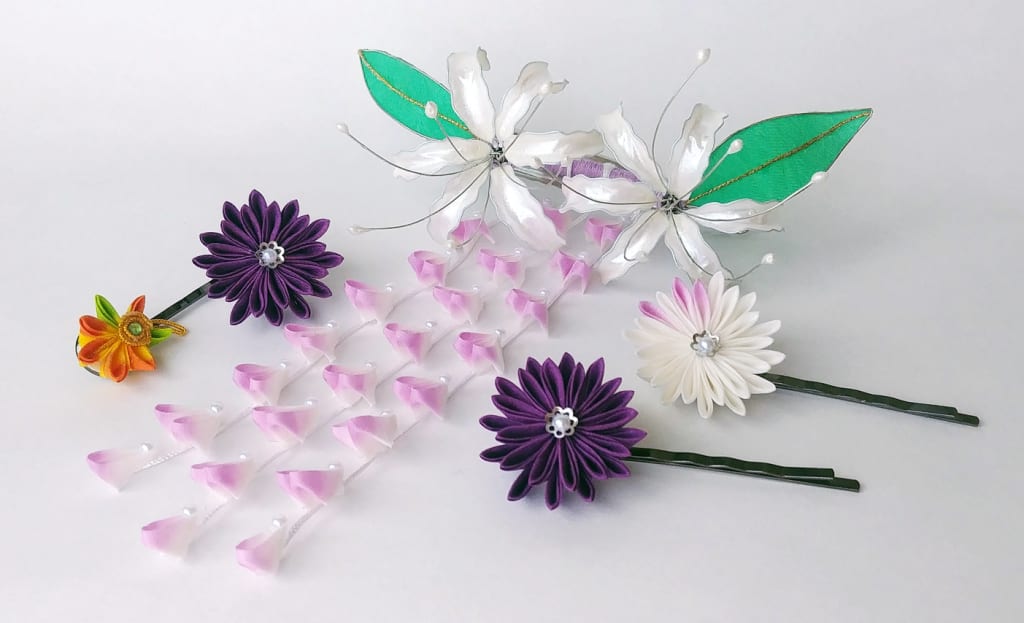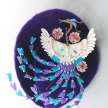Wedding Hair with Japanese Flair
Maiko style meets the modern bride.

As a craftsperson who often helps brides to create their wedding day look, I understand how difficult it can be to get it right. The search for perfection can add unnecessary stress. And, when you find yourself considering an accessory with roots in a culture other than your own, that adds a layer of concern in regards to cultural appropriation.
As a western person practising a Japanese art, I have found the best way to appreciate and honor the history of my craft is to study its history and help pass that knowledge forward.
Tsumami-zaiku (pinching craft) is the Japanese art of creating vibrant, often floral, arrangements of decorative silk. This craft form is most famously used to create the kanzashi (hair accessories) that maiko (apprentice geisha) wear according to the seasons, but Japanese women also wear them for formal events like weddings and graduations.
This craft form was invented some 200 years ago to create a gift for the emporer - decorated kusudama (medicine balls that are usually made with fresh flowers) - and spread from the nobility out to the countryside to become accessories for all women. Today it's not uncommon for people practice tsumami-zaiku as a hobby.
Many soon to be brides find these hair accessories very appealing, and pin them on their pinterest boards even if they can't pick them up directly from the source. With the advent of the internet, it's become much easier to find tsumami kanzashi - you can now buy them on websites like Etsy, and from craftsmen who live all over the world.

Western weddings complete with the big white dress and bouquets of flowers have become quite popular in Japan, often following the more traditional Shinto ceremony. Tsumami-zaiku has also seen a resurgence in recent years, and has been used to create not only hair accessories, but boutonnieres, ring bearer pillows, and even whole bouquets.
Japan, in general, has a fondness for adopting western styles and giving them a unique Japanese spin (for example, the ubiquitous Japanese school uniform is a riff on western military or catholic school uniforms) so it's no surprise that the Tsumami-zaiku Association of Japan also encourages cultural exchange.
Their goal is to change the perception of tsumami-zaiku from "made in Japan to roots in Japan" and to foster innovation through connecting the experience of tsumami-zaiku to the rest of the world. Their support and guidance has made it possible for many artisans the world over to start producing tsumami-zaiku with the most authentic materials and techniques possible.

If you're interested in wearing tsumami kanzashi for your big day, but are concerned about selecting something appropriate, there are a few things to keep in mind.
Seasonality: Traditionally, kanzashi are worn according to season. You can break those seasons down by month, which is how many kanzashi calendars do things, or by the Japanese traditional calendar that has far more than four seasons. But, in general flowers that bloom in the spring are worn in the spring, and so forth
Some kanzashi designs are only worn for specific holidays or events in the life of a maiko, but in general if you're wearing kanzashi that align with the season your event takes place in, you should be all right.
If you're having a hard time placing the season your kanzashi should be worn in, it might be good to do a little research into what kind of kanzashi you're looking at before moving ahead.

Non-Traditional Designs: That said, many modern kanzashi don't follow the traditional seasonal canons of design or have wildly non-traditional color palettes. Kanzashi can vary just as widely as the many types of street fashion you see on the streets of Harajuku and beyond. These kanzashi are not specifically intended for maiko or geisha to wear, and can be worn freely to match your personal style.
Many tsumami-zaiku craftsmen are also utilizing their craft in unexpected ways. For example, many short-haired brides probably think head bands or clips are the only way to go, but floral ear cuffs like the one pictured below are also a great option.

At the end of the day, your wedding should be a celebration of love, and I would hope that you love everything that you wear. I am sure that with care and consideration you can find a tsumami kanzashi that speaks to you, and I hope that you can wear it with the joy that this traditional handicraft is meant to give.
About the Creator
Apple Dainty
Tsumami-zaiku craftsperson based out of Canada.






Comments
There are no comments for this story
Be the first to respond and start the conversation.